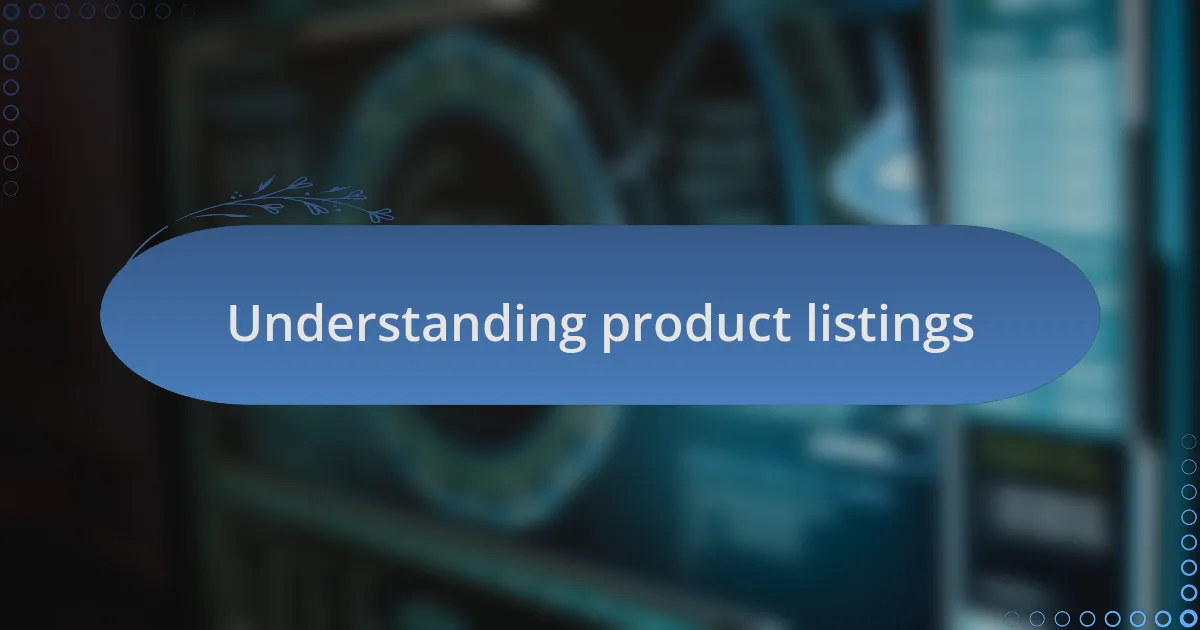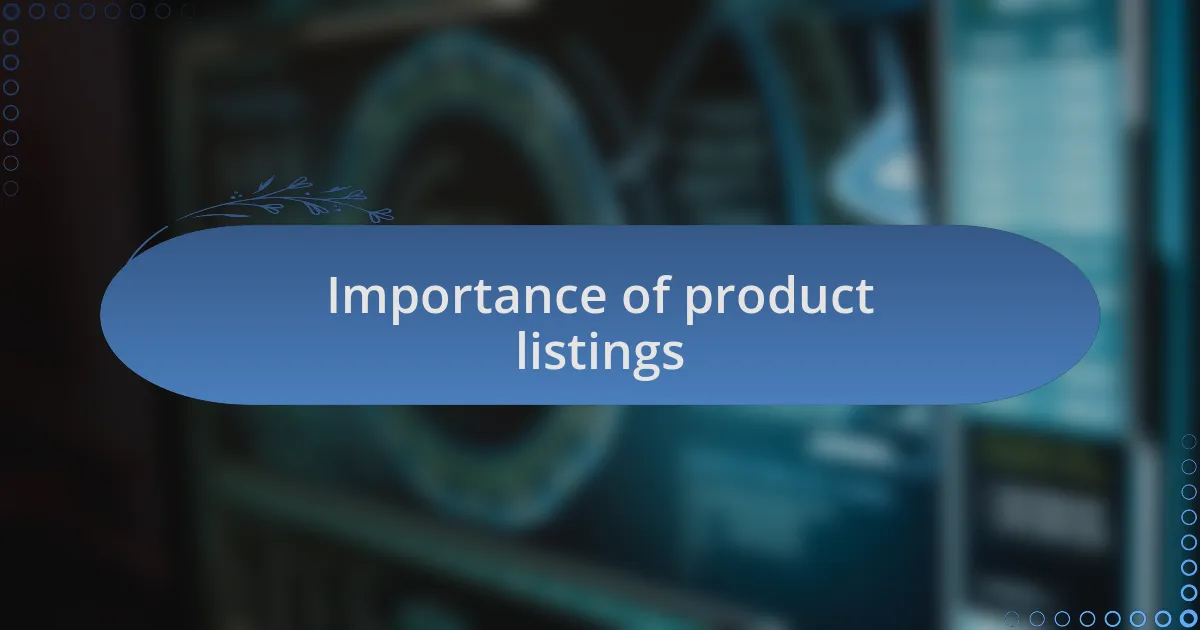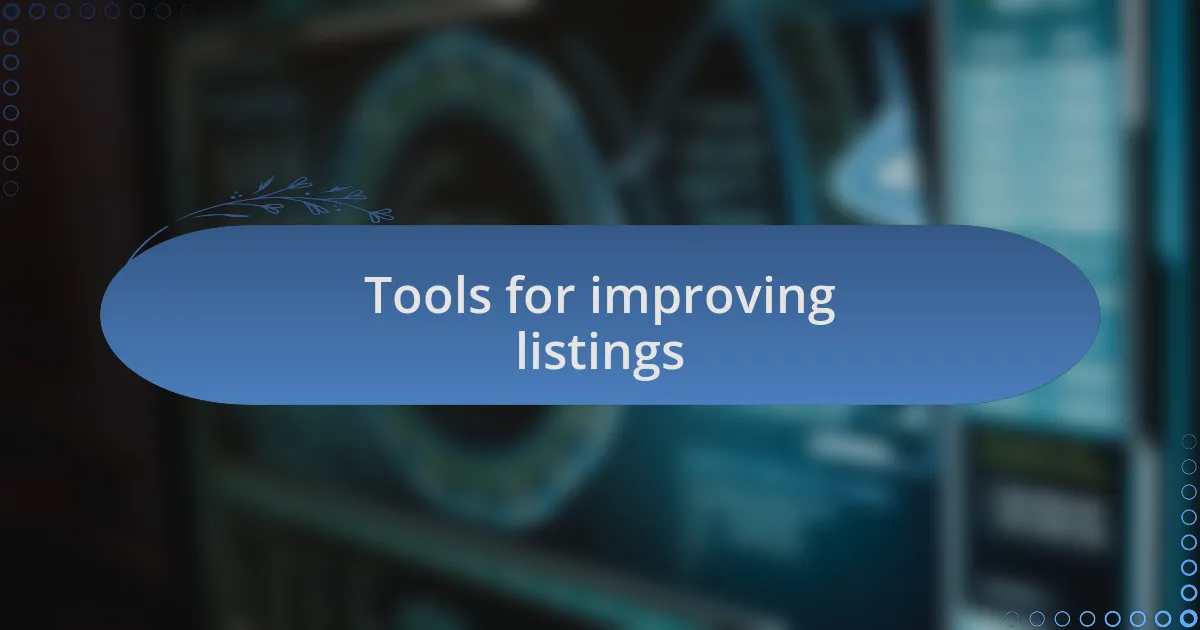Key takeaways:
- Product listings create the first impression for potential clients; clarity, compelling visuals, and concise descriptions are essential for engagement.
- Testing and refining listings through A/B testing and analytics can significantly improve performance and user interaction.
- Incorporating client testimonials and storytelling enhances credibility and emotional connection, making listings more relatable and trustworthy.
- Continuous improvement based on user feedback is crucial for adapting listings to meet clients’ needs effectively.

Understanding product listings
Product listings are the first impression potential customers get of your services. I remember when I first launched my web development services; I realized how critical it was to not only showcase what I offered but to enchant potential clients with visuals and compelling descriptions. When they clicked on my listings, I wanted them to feel the expertise and passion behind each offering.
Every element of a product listing matters—titles, images, and descriptions all work together to create a narrative. I learned this the hard way when I had a beautifully crafted service, but my listing’s title was too vague. It made me wonder, how many possible clients missed out simply because they didn’t understand what I was offering at a glance?
Additionally, understanding your target audience helps shape your product listings effectively. I often ask myself, what questions might my clients have? When I addressed these inquiries directly in my listings, I felt more connected to my audience, and I saw an increase in engagement. It’s about creating a dialogue, not just a listing; that’s where the real magic happens.

Importance of product listings
Effective product listings play a pivotal role in attracting potential clients. I remember tweaking my descriptions based on customer feedback; suddenly, I noticed a shift in engagement. It made me reflect: how much are customers drawn in by language and clarity? It turns out, the right words can paint a vivid picture that resonates with your audience.
Consider this: what happens when a product listing fails to convey key details? In my early days, I had a landing page that was visually stunning but didn’t highlight the unique features of my services. After realizing this, I revamped the listing to include specific benefits and outcomes, and that small change led to a surge in inquiries. It made me appreciate how critical clarity is in guiding potential clients.
Lastly, visuals are equally essential in product listings. I started using high-quality images and saw how they transformed perceptions. When potential clients can visualize the end product of my services, the connection feels real. It’s almost like they can see the value before even making contact. This trip down memory lane reminds me that first impressions truly do matter; they set the stage for the relationship to flourish.

Best practices for product listings
When it comes to crafting effective product listings, one of the best practices I’ve adopted is focusing on clear, concise descriptions. In my experience, breaking down service features into digestible bullet points made it easier for potential clients to quickly grasp the unique value I brought to the table. It’s fascinating how simplifying complex information can actually enhance interest—why wouldn’t you want your clients to know exactly what they can expect?
Another thing to consider is the importance of including social proof in your listings. I vividly recall adding customer testimonials to my product pages, and the impact was immediate. Clients seemed more at ease, often mentioning how they appreciated seeing feedback from others who had benefited from my services. Isn’t it interesting how a few words of trust can significantly increase someone’s confidence in choosing your offering?
On a practical note, I realized that utilizing A/B testing was a game changer for my product listings. By experimenting with different headlines and images, I could see what resonated best with my audience. I remember when a simple tweak in phrasing led to a 30% increase in clicks! This process not only fine-tuned my listings but also reminded me that continuous improvement is essential; after all, how can we know what works best without testing?

Tools for improving listings
To enhance my product listings, I found that using SEO tools was incredibly beneficial. I recall spending an afternoon analyzing keywords with tools like SEMrush; it was eye-opening to see how incorporating specific phrases improved my visibility. Have you ever wondered how the right words can draw in organic traffic? I definitely have, and it’s a game changer for ensuring your services are seen by those who truly need them.
Another handy tool I embraced was the use of analytics platforms, such as Google Analytics. I remember the first time I dove into the data; it revealed surprising insights about user behavior. By identifying drop-off points on my listings, I could refine my approach, ensuring my content kept visitors engaged. It brings to mind the importance of being adaptable—why wait for feedback when you can seek it out proactively?
Lastly, I cannot stress enough how graphic design tools like Canva helped me elevate the visual appeal of my service listings. There was a time when I relied solely on text, and everything felt a bit lackluster. After experimenting with infographics and custom images, I noticed not just a spike in engagement, but also an increased interest in my offerings. Doesn’t it feel rewarding to see how aesthetics can truly complement substance?

Analyzing performance of listings
Examining the performance of my listings was a revealing experience. I distinctly remember sitting down one evening, sifting through conversion rates and bounce rates. It struck me just how crucial these metrics were. Identifying a high bounce rate on specific listings pushed me to reevaluate both the content and layout. I asked myself, “What’s not connecting here?” This questioning led me to make informed changes that significantly improved user engagement.
Throughout my analysis, I also paid close attention to user feedback. I was surprised to find that direct comments often highlighted issues I hadn’t even noticed. Engaging with my audience allowed me to empathize with their experiences—after all, they are the ones navigating my listings. I learned the importance of listening; it’s like having a conversation where their insights can guide my next steps.
A pivotal moment came when I started A/B testing different versions of my listings. One day, I decided to change the call-to-action button color; that small tweak doubled the click-through rate on one particular service. It made me realize how small adjustments can lead to significant shifts in performance. Have you ever underestimated the impact of seemingly minor details? I certainly did, but now I approach my listings with a more meticulous eye.

My personal experience with listings
Reflecting on my journey with listings, I recall the moment I first launched my web development services online. I was excited but also nervous, wondering if potential clients would resonate with what I presented. It felt like sending my creations into the world, and I was eager for feedback. However, initial results were underwhelming, prompting an internal dialogue that pushed me to dig deeper into what truly mattered to my audience.
As I navigated through the various challenges, I found myself experimenting with storytelling in my listings. I shared case studies that illustrated my process and results, transforming bland text into engaging narratives. This approach not only captivated visitors but also sparked memories of past projects I cherished. I often thought, “How can I convey my passion for web development in a way that feels relatable?” Sharing those stories became a key element, helping potential clients connect with my services on a personal level.
There was also a time when I decided to survey clients post-project completion. The insights were enlightening; many expressed their need for clarity and assurance before making a decision. I remember one client, in particular, shared how a detailed project timeline alleviated her concerns. It was a lightbulb moment for me—why not integrate more transparency into my listings? This realization shifted my focus significantly, making me appreciate the importance of not just selling a service, but building trust through well-structured listings.

Tips to enhance your listings
To truly enhance your listings, I found that incorporating clear visuals made a world of difference. I remember the first time I uploaded a client project showcase—suddenly, the narrative transformed. Imagery drew visitors in, inviting them to visualize the outcomes I achieved. It’s amazing how a well-placed screenshot or a before-and-after comparison can create an emotional connection. Have you considered how visuals could elevate your own listings?
Another strategy that proved fruitful was the integration of client testimonials directly within the listings. I recall one glowing review that not only validated my efforts but also highlighted the personal touch I bring to my projects. By strategically placing this testimonial alongside relevant service details, I enhanced credibility instantly. The honesty and warmth of those words resonated with new visitors, encouraging them to explore further. Is there a client story that you think could serve a similar purpose?
Lastly, I realized the power of concise and compelling language. At one point, I took a hard look at my listings and trimmed any jargon that could alienate potential clients. I drafted descriptions that felt more like conversations than formal presentations. This shift was liberating—it allowed me to connect authentically with my audience. Have you tried simplifying your messaging to foster a deeper connection? It’s surprising how much more engagement arises when you speak your audience’s language.